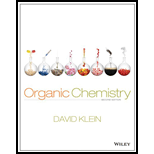
(a)
Interpretation: For a given set of molecules the number of signals expected in
Concept Introduction:
Homotopic: If the protons are interchangeable through rotational symmetry, then the protons are chemically equivalent and termed as homotopic.
Enantiotopic protons: If subjected protons in the molecule can be interchanged through rotational or reflection symmetry known as Enantiotopic protons and the protons are chemically equivalent.
Diastereotopic: If the protons are not interchangeable through either of the symmetry operations, then the protons are Diastereotopic; the protons are not chemically equivalent if a chiral center present in the molecule.
Replacement test: In the molecule; if replacing each one of the subjected protons with deuterium gives the two compounds are same; then the protons are chemically equivalent.
(b)
Interpretation: For a given set of molecules the number of signals expected in
Concept Introduction:
Homotopic: If the protons are interchangeable through rotational symmetry, then the protons are chemically equivalent and termed as homotopic.
Enantiotopic protons: If subjected protons in the molecule can be interchanged through rotational or reflection symmetry known as Enantiotopic protons and the protons are chemically equivalent.
Diastereotopic: If the protons are not interchangeable through either of the symmetry operations, then the protons are Diastereotopic; the protons are not chemically equivalent if a chiral center present in the molecule.
Replacement test: In the molecule; if replacing each one of the subjected protons with deuterium gives the two compounds are same; then the protons are chemically equivalent.
(c)
Interpretation: For a given set of molecules the number of signals expected in
Concept Introduction:
Homotopic: If the protons are interchangeable through rotational symmetry, then the protons are chemically equivalent and termed as homotopic.
Enantiotopic protons: If subjected protons in the molecule can be interchanged through rotational or reflection symmetry known as Enantiotopic protons and the protons are chemically equivalent.
Diastereotopic: If the protons are not interchangeable through either of the symmetry operations, then the protons are Diastereotopic; the protons are not chemically equivalent if a chiral center present in the molecule.
Replacement test: In the molecule; if replacing each one of the subjected protons with deuterium gives the two compounds are same; then the protons are chemically equivalent.
Want to see the full answer?
Check out a sample textbook solution
Chapter 16 Solutions
Organic Chemistry
 ChemistryChemistryISBN:9781305957404Author:Steven S. Zumdahl, Susan A. Zumdahl, Donald J. DeCostePublisher:Cengage Learning
ChemistryChemistryISBN:9781305957404Author:Steven S. Zumdahl, Susan A. Zumdahl, Donald J. DeCostePublisher:Cengage Learning ChemistryChemistryISBN:9781259911156Author:Raymond Chang Dr., Jason Overby ProfessorPublisher:McGraw-Hill Education
ChemistryChemistryISBN:9781259911156Author:Raymond Chang Dr., Jason Overby ProfessorPublisher:McGraw-Hill Education Principles of Instrumental AnalysisChemistryISBN:9781305577213Author:Douglas A. Skoog, F. James Holler, Stanley R. CrouchPublisher:Cengage Learning
Principles of Instrumental AnalysisChemistryISBN:9781305577213Author:Douglas A. Skoog, F. James Holler, Stanley R. CrouchPublisher:Cengage Learning Organic ChemistryChemistryISBN:9780078021558Author:Janice Gorzynski Smith Dr.Publisher:McGraw-Hill Education
Organic ChemistryChemistryISBN:9780078021558Author:Janice Gorzynski Smith Dr.Publisher:McGraw-Hill Education Chemistry: Principles and ReactionsChemistryISBN:9781305079373Author:William L. Masterton, Cecile N. HurleyPublisher:Cengage Learning
Chemistry: Principles and ReactionsChemistryISBN:9781305079373Author:William L. Masterton, Cecile N. HurleyPublisher:Cengage Learning Elementary Principles of Chemical Processes, Bind...ChemistryISBN:9781118431221Author:Richard M. Felder, Ronald W. Rousseau, Lisa G. BullardPublisher:WILEY
Elementary Principles of Chemical Processes, Bind...ChemistryISBN:9781118431221Author:Richard M. Felder, Ronald W. Rousseau, Lisa G. BullardPublisher:WILEY





